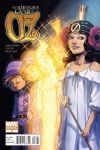1989: Year Without a Robin?
 As 1989 began, it was the first year since 1940 that DC Comics had no character named Robin appearing (at least occasionally) as Batman’s young assistant. Toward the end of the previous year, fans had voted to let the Joker kill Jason Todd, the latest Robin.
As 1989 began, it was the first year since 1940 that DC Comics had no character named Robin appearing (at least occasionally) as Batman’s young assistant. Toward the end of the previous year, fans had voted to let the Joker kill Jason Todd, the latest Robin.
The Batman editorial team was reeling from fans’ criticism of the character of Jason and from wider criticism of the decision to show his death. Interviews and introductions to Batman collections published around that time show how editor Dennis O’Neil was feeling more than a little shell-shocked.
To be sure, the company was still publishing stories about Dick Grayson, the original Robin, in his new guise as Nightwing. Those stories, in The New Titans, were among the company’s top sellers. And DC still owned the Robin trademark, which had been a source of licensing revenue for decades. But there was no Robin in the Batman comic books, and at least a possibility that there would be no replacement.
That year looked like it would be huge for Batman. It was the fiftieth anniversary of when the character debuted (without Robin). Warner Bros. would bring out a major Batman movie by director Tim Burton in the summer (without Robin). Furthermore, some graphic novels had pushed Batman into more adult territory, including Mike W. Barr and Jerry Bingham’s Son of the Demon (1987), and Alan Moore and Brian Bolland’s The Killing Joke (1988). Neither of those volumes included Robin.
Furthermore, some graphic novels had pushed Batman into more adult territory, including Mike W. Barr and Jerry Bingham’s Son of the Demon (1987), and Alan Moore and Brian Bolland’s The Killing Joke (1988). Neither of those volumes included Robin.
Frank Miller’s future-set The Dark Knight Returns (1986) debuted a new Robin in Carrie Kelley, but also presciently portrayed Jason Todd as dead and Dick Grayson as estranged from his mentor—hinting that there had been no Robin for years.
In fact, some comics readers and creators were insisting that Robin no longer made sense in the Batman mythos. Grant Morrison couldn’t convince Dave McKean to include Jason in their Arkham Asylum: A Serious House on Serious Earth graphic novel, due to be published in 1989. Morrison later wrote:
The original first draft of the script included the character of Robin as Batman’s sidekick. Robin appeared in a few scenes at the beginning then remained at Police Headquarters for the bulk of the book, where he spent his time studying plans and histories of the house, in order to find a way in to help his mentor.
Dave McKean, however, felt that he had already compromised his artistic integrity sufficiently by drawing Batman and refused point blank to bend over for the Boy Wonder—so after one brave but ridiculous attempt to put him in a trench coat, I wisely removed him from the script.
The Batman movie became a huge hit, spawning three sequels. (I didn’t care for it myself.) Arkham Asylum, benefiting from coming out alongside the movie, sold half a million copies. Batman comic-book sales soared. Those developments helped touch off a speculative boom in the comics industry over the next few years. In sum, it didn’t look like Batman needed Robin to be a hit anymore.
But O’Neil and his writers were already planning a replacement for Jason Todd.
COMING UP: Her name was the Huntress.







 As recent
As recent  To explain myself, I turn once again to this passage from
To explain myself, I turn once again to this passage from  Jason’s death in late 1988 clarified the mysteries in a most final way. The angry, disobedient teen was now the personality people would most remember, and there was an end to his story, defining its meaning.
Jason’s death in late 1988 clarified the mysteries in a most final way. The angry, disobedient teen was now the personality people would most remember, and there was an end to his story, defining its meaning.


 To be fair, the readership for Babymouse starts younger than the teens/tweens Larson was polling. But it does suggest that the more salient finding than the above is “5) Girls need good stories in a variety of genres.”
To be fair, the readership for Babymouse starts younger than the teens/tweens Larson was polling. But it does suggest that the more salient finding than the above is “5) Girls need good stories in a variety of genres.”

 The response, probably written by Assistant Editor Dan Raspler, provided the narrative justifications for Jason’s death and then passed the buck to the people who had actually decided on it:
The response, probably written by Assistant Editor Dan Raspler, provided the narrative justifications for Jason’s death and then passed the buck to the people who had actually decided on it: 









